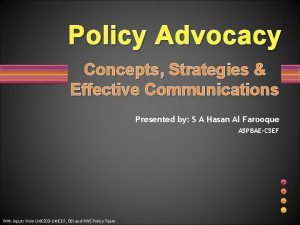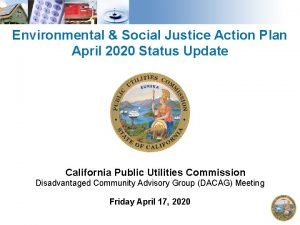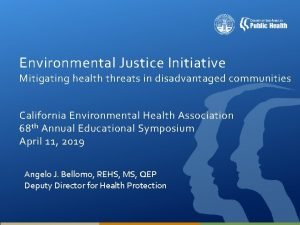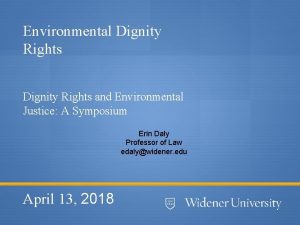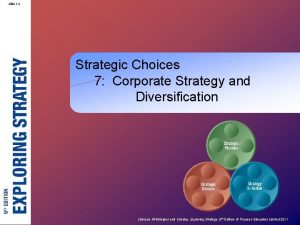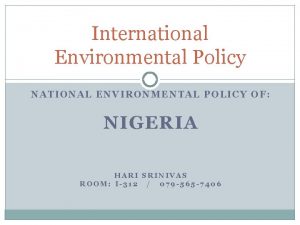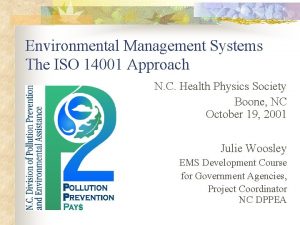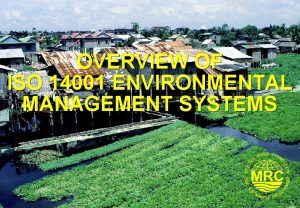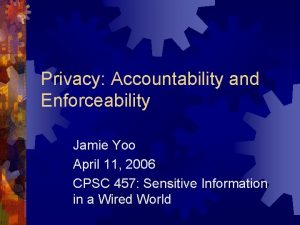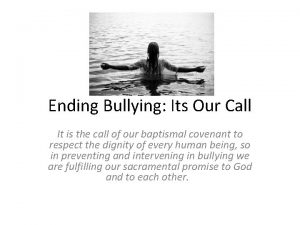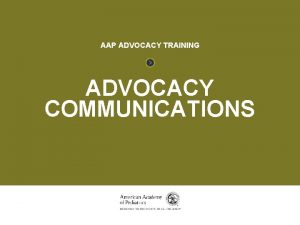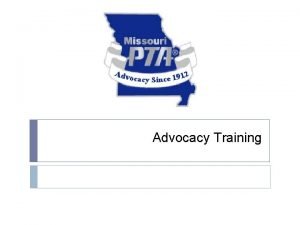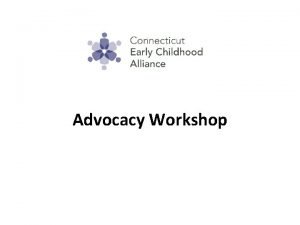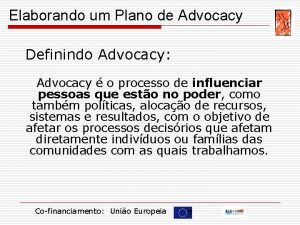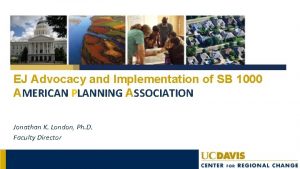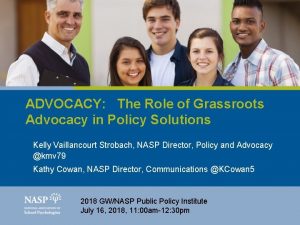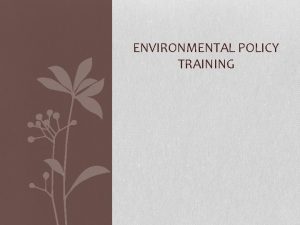ENVIRONMENTAL JUSTICE POLICY ADVOCACY Jamie Cole Policy Manager


























- Slides: 26

ENVIRONMENTAL JUSTICE POLICY ADVOCACY Jamie Cole Policy Manager NC Conservation Network

We are a statewide network of over 60 environmental, community and environmental justice organizations focused on protecting North Carolina’s environment and public health. Our vision is for diverse groups to engage in environmental policy decision-making at all levels of government – creating a North Carolina committed to improving and protecting the state’s vast natural resources, fostering environmental justice, and ensuring healthy, sustainable communities with a high quality of life.

Birthplace of Environmental Justice: Warren County, NC – PCB Landfill

Environmental Justice Fair Treatment Meaningful Involvement …of all people regardless of race, color, national origin, or income, with respect to the development, implementation, and enforcement of environmental laws, regulations, and policies.

Existing Authority & Tools • NC Constitution, Article I, Section 19 • Title VI of the Civil Rights Act of 1964 • National Environmental Policy Act • Executive Oder 12898 – President Bill Clinton • NC Environmental Equity Initiative • NC General Statute 130 A-294(a)(9) – Solid Waste Program • US EPA EJSCREEN • NC DEQ Public Participation Plan • NC Environmental Justice Mapping Tool • NC DEQ Secretary’s Environmental Justice and Equity Advisory Board

Federal EJ Tools: National Environmental Policy Act (NEPA) • Federal agencies must consider environmental justice in their activities under the National Environmental Policy Act (NEPA).

EJ Screen 6/5/2021 Add a footer 7

Federal EJ Tools

Federal EJ Plan: EJ 2020 Action Agenda: The U. S. EPA’s Environmental Justice Strategic Plan for 2016 -2020 A continuation of EJ 2014, this document serves as a road map for how the federal government will integrate EJ considerations within their infrastructure.

Gaps & Barriers • Public Participation • Rulemaking - Environmental Management Commission • CAFOs & Other Permitting • Lack of Statewide Priority Setting • False Narratives • North Carolina General Assembly

Not in My Back Yard (NIMBY) is not Environmental in. Justice. Why? • EJ indicators are not present • Susceptibility level is low • Generally OK with the “intruder” as long as it is not in their community. • NIMBY Target Examples: Habitat for Humanity, Public Transportation, Assisted Living Facilities and other facilities typically utilized by demographics such as minority and low-income.

NC DEQ’s Mapping Tool 6/5/2021 Add a footer 12

Equity All residents have an equal opportunity to benefit from environmental and climate solutions. Ensuring that those communities do not take on an un-equal burden of the environmental and climate impacts. 6/5/2021 Image Captured from: https: //www. storybasedstrategy. org/the 4 thbox/ 13

EJ Communities Overburdened Communities • Minority, low-income, tribal and indigenous populations or communities in the U. S. that potentially experience disproportionate environmental harms and risks due to exposures or cumulative impacts or greater vulnerability to environmental hazards. • The increased vulnerability may be attributable to an accumulation of negative and lack of positive environmental, health, economic, or social conditions within these populations or communities.

Cumulative Risks and Impacts Cumulative Risks Cumulative Impacts • Cumulative Risks are an analysis, characterization, and possible quantification of the combined risks to human health or the environment from multiple agents or stressors. • Cumulative Impacts are the effects of an action (federal, state, local, or private) that are added to or interact with other effects in a particular place and within a particular time. Cumulative Impacts result in the compounding of the effects of all actions over time. • Cumulative Risk Assessments are the evaluation of the combined risks from aggregate exposure to multiple agents or stressors.

CAFOS


Hogs: Duplin • Humans – 59, 039 • Hogs – 2, 334, 134 • Wet waste output – 2, 063, 146, 270 gallons per year Sampson • Humans – 63, 430 • Hogs – 2, 137, 525 • Wet waste output – 1, 938, 728491 gallons per year U. S. Census 2017 data Environmental Working Group and Waterkeeper Alliance, 2016 “Exposing Fields of Filth”.

A hog farm is inundated with floodwaters from Hurricane Florence near Trenton, N. C. , Sunday, Sept. 16, 2018. (AP Photo/Steve Helber)

Poultry: • In Duplin and Sampson alone – there are 82 million chicken and turkeys on top of 4 million pigs • Poultry operations “are now a much larger source of nutrient pollution in NC than swine farms. • CAFOs are in areas prone to flooding • Poultry waste is mostly converted into dry litter and stored in large piles. These piles can be blown by wind or washed by rain into nearby rivers. Source: Environmental Working Group, “Under the Radar: New Data Reveals NC Regulators Ignored Decade-Long Explosion of Poultry CAFOs” https: //www. ewg. org/research/underradar

CAFOs in NC – Permitted (NC DEQ)

CAFOs Permitted & Not Permitted

Advocacy Targets • Office of the Governor Department of • Environmental Quality Department of Agriculture • NC General Assembly • Environmental Management Commission • Local Government • US Environmental Protection Agency • US Congress

How can we overcome the barriers to environmental justice? • Don’t avoid the conversation. • Consider who benefits. • Consider why the community was chosen for the project. • Consider what the impacted community has to say about this action. • Consider how much information the community has about the action and where the information came from.

THANK YOU!

Jamie Cole Jamie@ncconservationnetwork. org 919 -857 -4699
 What is policy advocacy
What is policy advocacy Cpuc esj action plan
Cpuc esj action plan What is environmental justice
What is environmental justice What is environmental justice
What is environmental justice Cjpp guelph
Cjpp guelph Senior manager vs general manager
Senior manager vs general manager Portfolio manager synergy manager parental developer
Portfolio manager synergy manager parental developer Wireless health
Wireless health Secure remote service
Secure remote service Mobil livesco
Mobil livesco Iso 14001 environmental policy statement examples
Iso 14001 environmental policy statement examples Chapter 2 economics and environmental policy
Chapter 2 economics and environmental policy Iso 14001 environmental policy examples
Iso 14001 environmental policy examples Esp gmu
Esp gmu Jamie morgenstern
Jamie morgenstern Rosa has decided to sell pet rocks
Rosa has decided to sell pet rocks What is inductive and deductive method
What is inductive and deductive method Jamie varney
Jamie varney Leukoplakia niehomogenna
Leukoplakia niehomogenna Yesenia aguilar disney
Yesenia aguilar disney Jamie tried to solve an equation step by step.
Jamie tried to solve an equation step by step. Jamie stolk
Jamie stolk Jamie asaka
Jamie asaka Complicaciones de la pancreatitis
Complicaciones de la pancreatitis Jamie markham
Jamie markham Jamie yoo
Jamie yoo Jamie nabozny
Jamie nabozny
